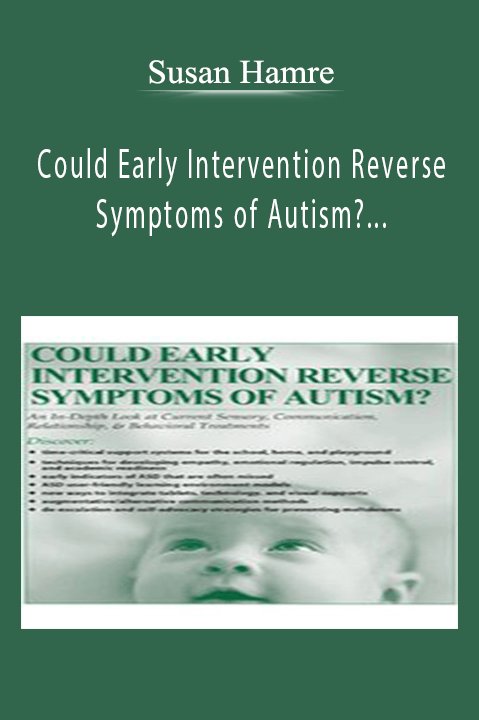Could Early Intervention Reverse Symptoms of Autism? An In-Depth Look at Current Sensory, Communication, Relationship, & Behavioral Treatments – Susan Hamre
Time is not your friend when working with children on the autism spectrum. Recent studies suggest the impact of early intervention can vastly improve outcomes, result in fewer communication and developmental delays, and possibly even eliminate symptoms – but timing is crucial.
This recording is designed to help attendees identify early indicators of ASD that are often missed and build time-critical support systems for fostering academic readiness, empathy, emotional regulation, and impulse control during the most formative years.
Interactive labs, videos, and case studies bring to life an effective multimodal approach as Susan Hamre, director of the Autism Trainer Center near Chicago, demonstrates real world applications and outcomes of today’s most effective early intervention strategies.
- Design critically timed support systems for individuals with ASD, combining evidence-based sensory, communication, relationship, and behavioral interventions
- Create an ASD user-friendly learning environment, seamlessly integrating tablets and technology with traditional interventions
- Distinguish between meltdowns and temper tantrums by understanding functions of underlying behavior
- Identify the dominating impact of environment, sensory, communication, and social challenges
- Evaluate the very early signs of possible ASD and identify treatment interventions
- Describe self-advocacy and de-escalation strategies that help parents and clinicians promote sustainable self-regulation and possibly prevent meltdowns
OVERVIEW
- Updated definition/clarification of ASD according to the DSM-5®
- Early intervention and bio-markers of ASD
- Latest research on possible causes of ASD
- Impact on families
- Case studies
STAYING CALM IN THE MIDDLE OF THE STORM
- Distinguishing between a meltdown and temper tantrum
- Functions of behavior
- Differential management of meltdowns vs. temper tantrums
- Understanding the trajectory of the storm
- Identify meltdown pre-cursors
- Noting triggers from impacted sensory system or communication challenges
- Calming strategies
- The repair period – post-escalation
- Managing YOU!
- Case studies
THE POWER OF SENSORY INTEGRATION
- Sensory systems impacted
- Neurological processing of input
- Seeking/avoiding sensory stimuli
- Sensory management strategies
- Sensory breaks
- Sensory diets
- Examples of supports
- Case studies
WHERE IS MY VOICE? – COMMUNICATION
- Communication challenges
- Apraxia
- Auditory processing
- Literal translations – black and white interpretations
- Spontaneous (social) language
- Augmentative/alternative communication strategies and cognitive development
- Picture communication system (PECS)
- AAC (iPads, apps, etc.)
- Gestural/ASL
- Scripts
- Choice boards
- Straight talk
- Case studies
ASPECTS OF SOCIAL-EMOTIONAL DEVELOPMENT
- Relationship of social-emotional development on cognition
- 5 features of social-emotional development
- Development of empathy, emotional regulation, and impulse control
- What happens when these skills are delayed or missing?
- How to help?
- Interacting at their level
- Video modeling
- Rules/expectations
- Social stories
- Pictures/sequences
- Engaging with their interests
- Case studies
DON’T UNDERESTIMATE THE IMPACT OF THE ENVIRONMENT
- Challenges (videos)
- Lights – “too busy”/over stimulating/distracting/too bright/“can’t see”
- Sounds – hallway noise/kids voices/ humming from technology/lights buzzing/pencils scratching
- Olfactory sensitivity
- Case study
- Kinesthetic – too crowded/kids touching/bumping in lines/too hot or cold
- Supports
- Organizing spaces
- Lighting adjustments
- Managing temperatures
- What to avoid
CURRENT INTERVENTIONS
- Early intervention
- Treatment strategies for infants and toddlers
- Case studies
- Relationship interventions
- Communication-based interventions
- Behavioral interventions
- Alternative interventions
VISUAL SUPPORTS – NOT JUST ANOTHER GIMMICK
- Who needs them?
- Benefits of using visual supports
- Examples of visual supports
- Case studies
DON’T FORGET MOTIVATION!
- Incorporating interests/fascinations vs. resisting them
- Building a bridge vs. dangling a carrot
- Intrinsic vs. extrinsic motivation
Instant Access Available
Product Content

Get Instant Access Could Early Intervention Reverse Symptoms of Autism? An In-Depth Look at Current Sensory, Communication, Relationship, & Behavioral Treatments – Susan Hamre at Offimc.click Now!
Sale page_https://catalog.pesi.com/item/34269/
Archive: https://archive.fo/aYB92
Delivery Information
- Upon ordering the product, a delivery email with download instructions will be sent immediately to you so that you may download your files. If you log in (or create an account) prior to purchase you will also be able to access your downloads from your account dashboard.
- It is a digital download, so please download the order items and save them to your hard drive. In case the link is broken for any reason, please contact us and we will resend the new download link to you.
- If you don't receive the download link, please don’t worry about that. We will update and notify you as soon as possible from 8:00 AM – 8:00 PM (UTC+8).
- Please Contact Us if there are any further questions or concerns you may have. We are always happy to assist!















10 reviews for Susan Hamre – Could Early Intervention Reverse Symptoms of Autism? An In–Depth Look at Current Sensory, Communication, Relationship, & Behavioral Treatments
There are no reviews yet.